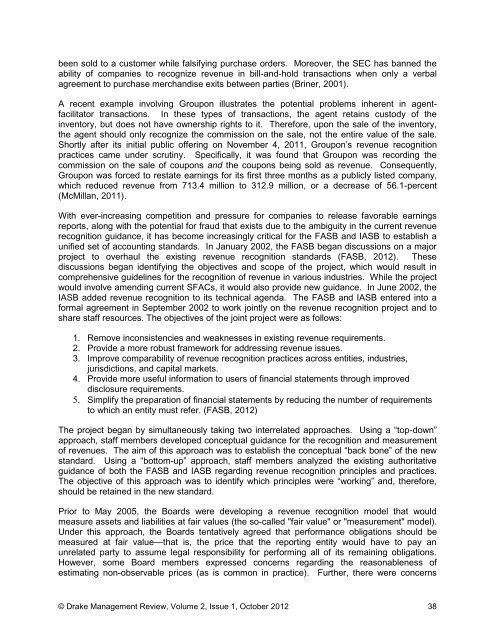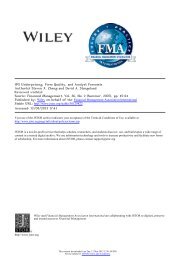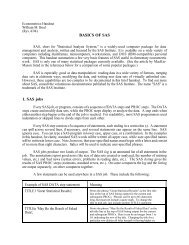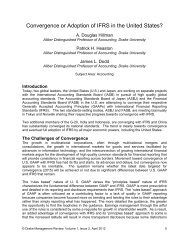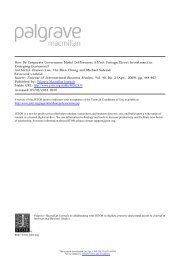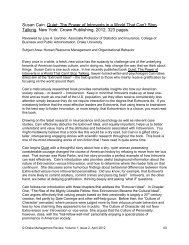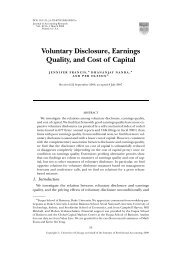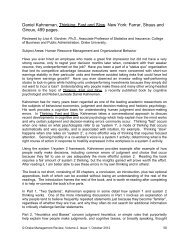IASB & FASB Convergence Project - Drake College of Business and ...
IASB & FASB Convergence Project - Drake College of Business and ...
IASB & FASB Convergence Project - Drake College of Business and ...
You also want an ePaper? Increase the reach of your titles
YUMPU automatically turns print PDFs into web optimized ePapers that Google loves.
een sold to a customer while falsifying purchase orders. Moreover, the SEC has banned theability <strong>of</strong> companies to recognize revenue in bill-<strong>and</strong>-hold transactions when only a verbalagreement to purchase merch<strong>and</strong>ise exits between parties (Briner, 2001).A recent example involving Groupon illustrates the potential problems inherent in agentfacilitatortransactions. In these types <strong>of</strong> transactions, the agent retains custody <strong>of</strong> theinventory, but does not have ownership rights to it. Therefore, upon the sale <strong>of</strong> the inventory,the agent should only recognize the commission on the sale, not the entire value <strong>of</strong> the sale.Shortly after its initial public <strong>of</strong>fering on November 4, 2011, Groupon’s revenue recognitionpractices came under scrutiny. Specifically, it was found that Groupon was recording thecommission on the sale <strong>of</strong> coupons <strong>and</strong> the coupons being sold as revenue. Consequently,Groupon was forced to restate earnings for its first three months as a publicly listed company,which reduced revenue from 713.4 million to 312.9 million, or a decrease <strong>of</strong> 56.1-percent(McMillan, 2011).With ever-increasing competition <strong>and</strong> pressure for companies to release favorable earningsreports, along with the potential for fraud that exists due to the ambiguity in the current revenuerecognition guidance, it has become increasingly critical for the <strong>FASB</strong> <strong>and</strong> <strong>IASB</strong> to establish aunified set <strong>of</strong> accounting st<strong>and</strong>ards. In January 2002, the <strong>FASB</strong> began discussions on a majorproject to overhaul the existing revenue recognition st<strong>and</strong>ards (<strong>FASB</strong>, 2012). Thesediscussions began identifying the objectives <strong>and</strong> scope <strong>of</strong> the project, which would result incomprehensive guidelines for the recognition <strong>of</strong> revenue in various industries. While the projectwould involve amending current SFACs, it would also provide new guidance. In June 2002, the<strong>IASB</strong> added revenue recognition to its technical agenda. The <strong>FASB</strong> <strong>and</strong> <strong>IASB</strong> entered into aformal agreement in September 2002 to work jointly on the revenue recognition project <strong>and</strong> toshare staff resources. The objectives <strong>of</strong> the joint project were as follows:1. Remove inconsistencies <strong>and</strong> weaknesses in existing revenue requirements.2. Provide a more robust framework for addressing revenue issues.3. Improve comparability <strong>of</strong> revenue recognition practices across entities, industries,jurisdictions, <strong>and</strong> capital markets.4. Provide more useful information to users <strong>of</strong> financial statements through improveddisclosure requirements.5. Simplify the preparation <strong>of</strong> financial statements by reducing the number <strong>of</strong> requirementsto which an entity must refer. (<strong>FASB</strong>, 2012)The project began by simultaneously taking two interrelated approaches. Using a “top-down”approach, staff members developed conceptual guidance for the recognition <strong>and</strong> measurement<strong>of</strong> revenues. The aim <strong>of</strong> this approach was to establish the conceptual “back bone” <strong>of</strong> the newst<strong>and</strong>ard. Using a “bottom-up” approach, staff members analyzed the existing authoritativeguidance <strong>of</strong> both the <strong>FASB</strong> <strong>and</strong> <strong>IASB</strong> regarding revenue recognition principles <strong>and</strong> practices.The objective <strong>of</strong> this approach was to identify which principles were “working” <strong>and</strong>, therefore,should be retained in the new st<strong>and</strong>ard.Prior to May 2005, the Boards were developing a revenue recognition model that wouldmeasure assets <strong>and</strong> liabilities at fair values (the so-called "fair value" or "measurement" model).Under this approach, the Boards tentatively agreed that performance obligations should bemeasured at fair value—that is, the price that the reporting entity would have to pay anunrelated party to assume legal responsibility for performing all <strong>of</strong> its remaining obligations.However, some Board members expressed concerns regarding the reasonableness <strong>of</strong>estimating non-observable prices (as is common in practice). Further, there were concerns© <strong>Drake</strong> Management Review, Volume 2, Issue 1, October 2012 38


